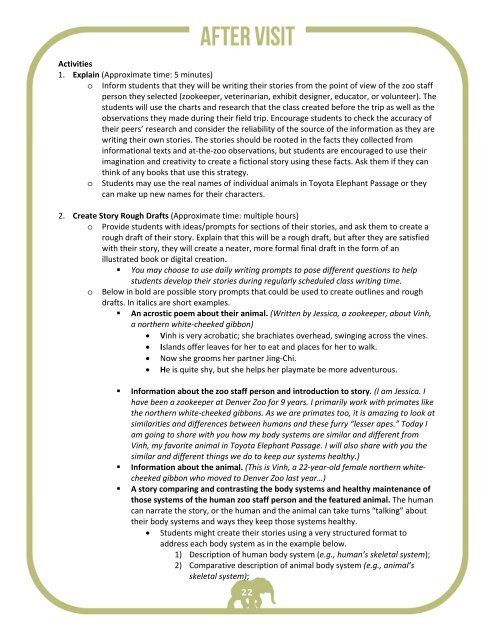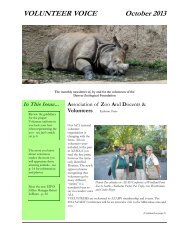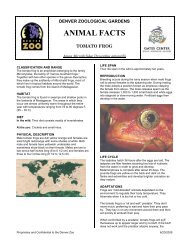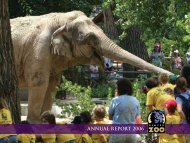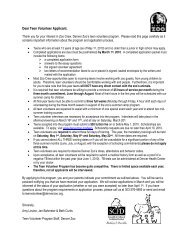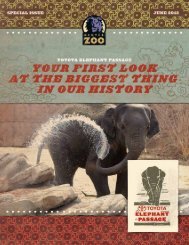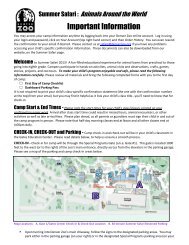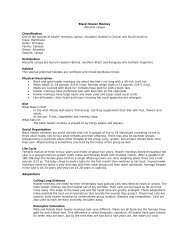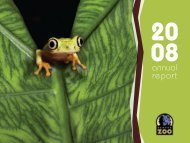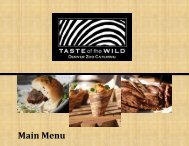Download Printer Friendly PDF - Denver Zoo
Download Printer Friendly PDF - Denver Zoo
Download Printer Friendly PDF - Denver Zoo
Create successful ePaper yourself
Turn your PDF publications into a flip-book with our unique Google optimized e-Paper software.
Activities1. Explain (Approximate time: 5 minutes)o Inform students that they will be writing their stories from the point of view of the zoo staffperson they selected (zookeeper, veterinarian, exhibit designer, educator, or volunteer). Thestudents will use the charts and research that the class created before the trip as well as theobservations they made during their field trip. Encourage students to check the accuracy oftheir peers’ research and consider the reliability of the source of the information as they arewriting their own stories. The stories should be rooted in the facts they collected frominformational texts and at‐the‐zoo observations, but students are encouraged to use theirimagination and creativity to create a fictional story using these facts. Ask them if they canthink of any books that use this strategy.o Students may use the real names of individual animals in Toyota Elephant Passage or theycan make up new names for their characters.2. Create Story Rough Drafts (Approximate time: multiple hours)o Provide students with ideas/prompts for sections of their stories, and ask them to create arough draft of their story. Explain that this will be a rough draft, but after they are satisfiedwith their story, they will create a neater, more formal final draft in the form of anillustrated book or digital creation.• You may choose to use daily writing prompts to pose different questions to helpstudents develop their stories during regularly scheduled class writing time.o Below in bold are possible story prompts that could be used to create outlines and roughdrafts. In italics are short examples.• An acrostic poem about their animal. (Written by Jessica, a zookeeper, about Vinh,a northern white‐cheeked gibbon) Vinh is very acrobatic; she brachiates overhead, swinging across the vines. Islands offer leaves for her to eat and places for her to walk. Now she grooms her partner Jing‐Chi. He is quite shy, but she helps her playmate be more adventurous.• Information about the zoo staff person and introduction to story. (I am Jessica. Ihave been a zookeeper at <strong>Denver</strong> <strong>Zoo</strong> for 9 years. I primarily work with primates likethe northern white‐cheeked gibbons. As we are primates too, it is amazing to look atsimilarities and differences between humans and these furry “lesser apes.” Today Iam going to share with you how my body systems are similar and different fromVinh, my favorite animal in Toyota Elephant Passage. I will also share with you thesimilar and different things we do to keep our systems healthy.)• Information about the animal. (This is Vinh, a 22‐year‐old female northern whitecheekedgibbon who moved to <strong>Denver</strong> <strong>Zoo</strong> last year…)• A story comparing and contrasting the body systems and healthy maintenance ofthose systems of the human zoo staff person and the featured animal. The humancan narrate the story, or the human and the animal can take turns “talking” abouttheir body systems and ways they keep those systems healthy. Students might create their stories using a very structured format toaddress each body system as in the example below.1) Description of human body system (e.g., human’s skeletal system);2) Comparative description of animal body system (e.g., animal’sskeletal system);22


